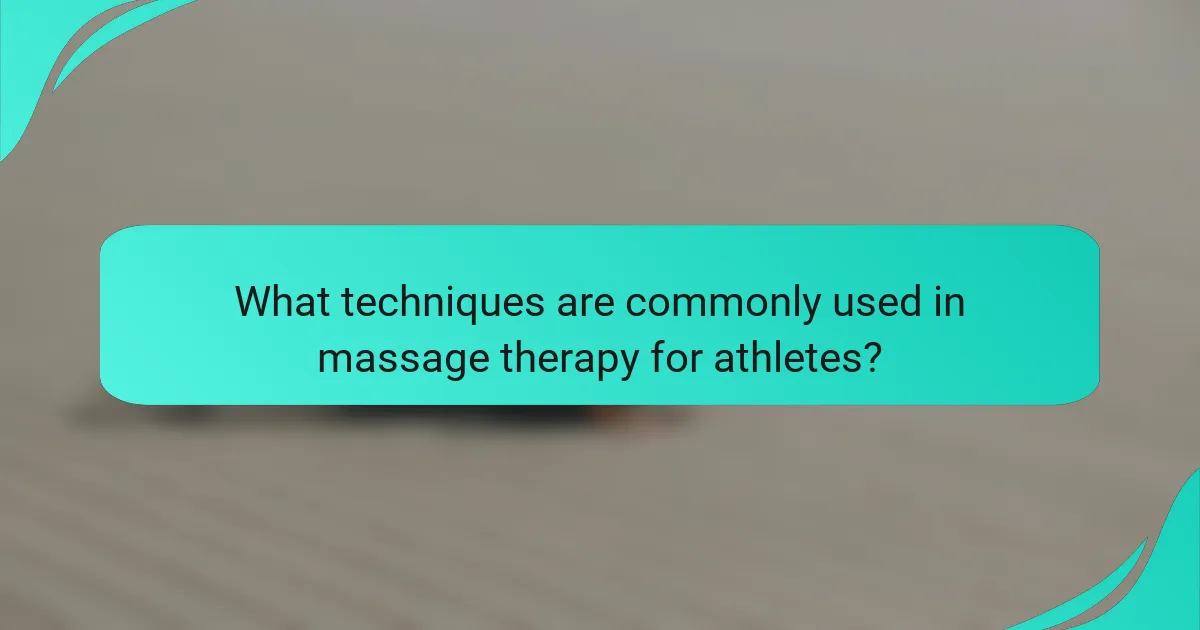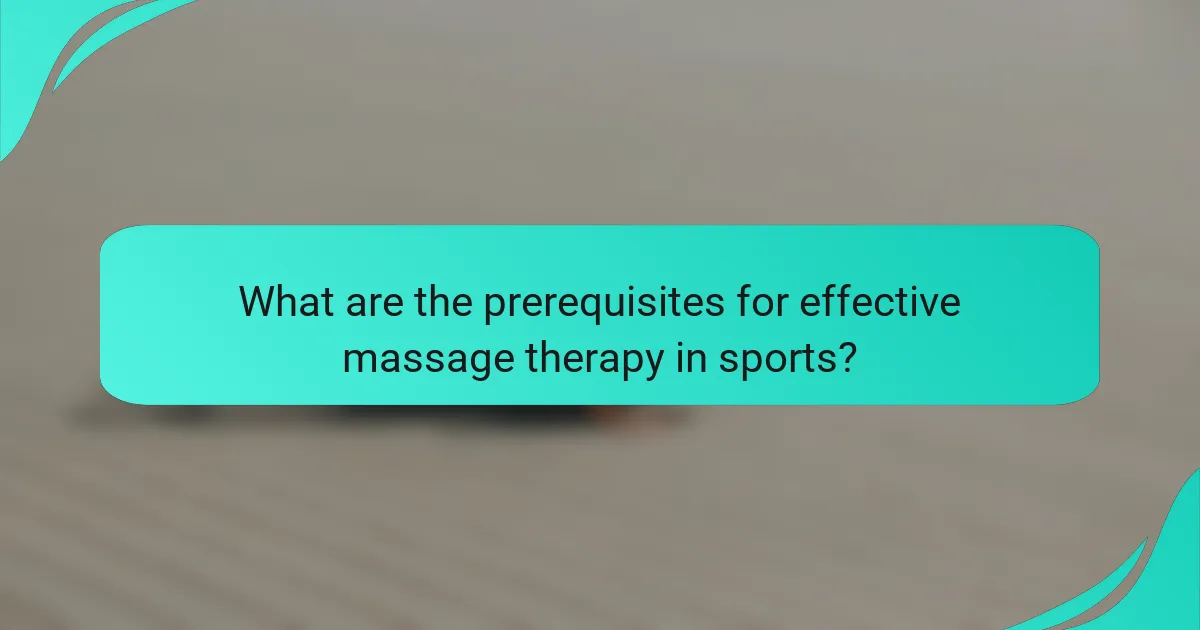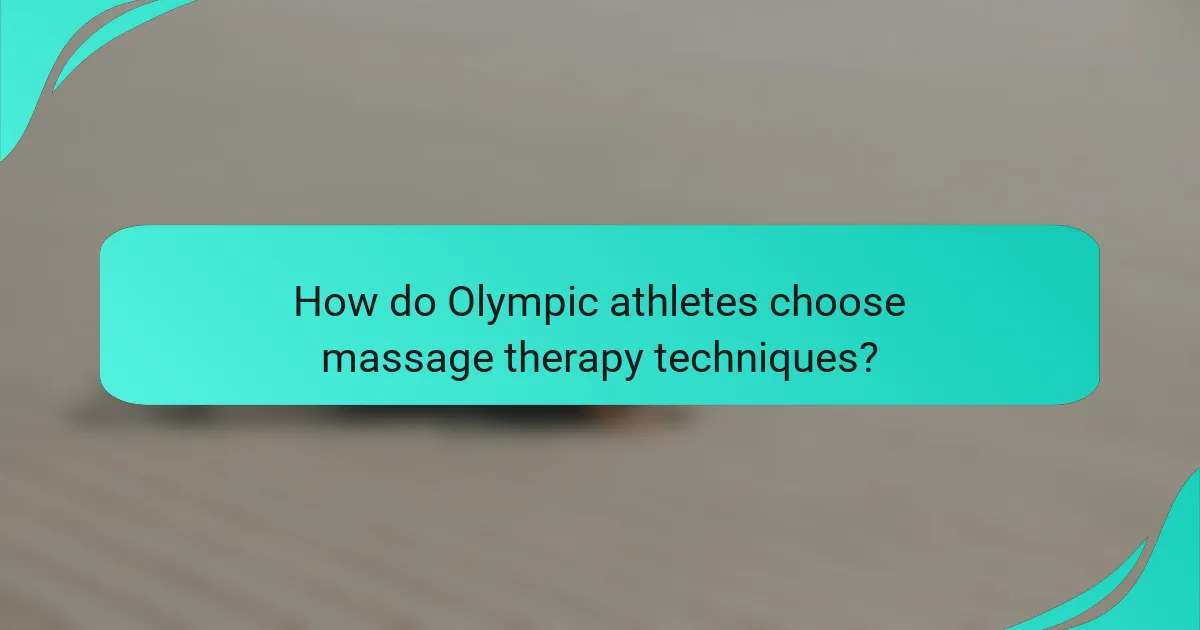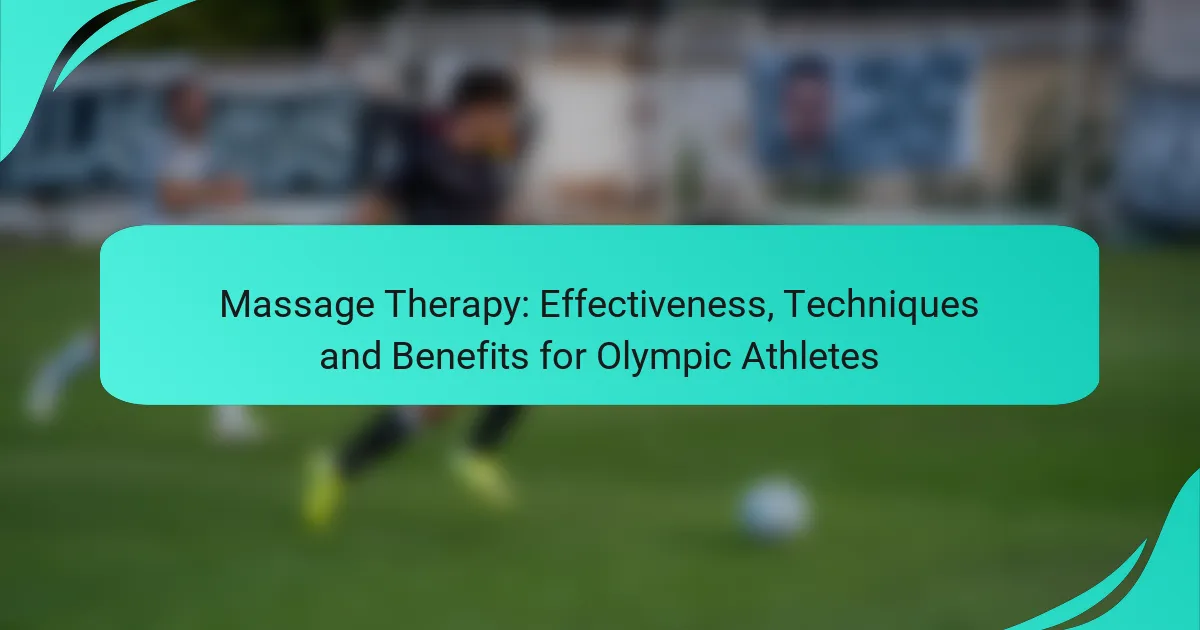Massage therapy plays a crucial role in the training and recovery of Olympic athletes, offering numerous benefits that enhance physical performance and well-being. By employing various techniques such as Swedish, deep tissue, and sports massage, athletes can experience reduced muscle soreness, improved circulation, and enhanced mental focus, all of which contribute to their competitive edge.

How does massage therapy benefit Olympic athletes?
Massage therapy offers significant benefits to Olympic athletes by enhancing their physical recovery, reducing muscle soreness, and improving overall performance. These advantages stem from the various techniques used in massage, which promote circulation, relieve tension, and support mental well-being.
Improves recovery time
Massage therapy can significantly improve recovery time for Olympic athletes by increasing blood flow and oxygen delivery to muscles. Enhanced circulation helps to remove metabolic waste products, such as lactic acid, which can accumulate during intense training or competition.
Regular massage sessions can lead to quicker recovery between workouts, allowing athletes to train more effectively and consistently. Athletes may benefit from scheduling massages post-training or competition to maximize recovery benefits.
Reduces muscle soreness
One of the primary benefits of massage therapy is its ability to reduce muscle soreness, particularly after strenuous physical activity. Techniques such as deep tissue massage can alleviate tightness and discomfort in muscles, making it easier for athletes to maintain their training schedules.
By incorporating massage into their routine, athletes can experience less delayed onset muscle soreness (DOMS), which can hinder performance. A typical recommendation is to have a massage within 24 hours after intense exertion to effectively manage soreness.
Enhances flexibility
Massage therapy enhances flexibility by loosening tight muscles and connective tissues, allowing for a greater range of motion. Improved flexibility is crucial for Olympic athletes, as it can lead to better performance and reduced risk of injury.
Stretching techniques used in massage can help athletes achieve optimal muscle elasticity. Regular sessions can be particularly beneficial before competitions to prepare the body for peak performance.
Boosts mental well-being
Massage therapy not only benefits the body but also supports mental well-being, which is essential for Olympic athletes facing high-pressure situations. The relaxation induced by massage can reduce stress and anxiety, helping athletes maintain focus and composure during competitions.
Incorporating massage into a training regimen can promote a positive mindset, leading to improved motivation and overall mental health. Athletes should consider scheduling regular massages as part of their holistic approach to training and competition preparation.

What techniques are commonly used in massage therapy for athletes?
Massage therapy for athletes often incorporates various techniques tailored to enhance performance, recovery, and overall well-being. The most commonly used methods include Swedish massage, deep tissue massage, sports massage, and trigger point therapy, each serving distinct purposes and benefits.
Swedish massage
Swedish massage is a gentle technique that promotes relaxation and improves circulation. It uses long strokes, kneading, and circular movements to relieve tension and enhance blood flow, making it ideal for athletes looking to unwind after rigorous training.
This method can be particularly beneficial before competitions to prepare the body and reduce anxiety. Athletes may schedule a Swedish massage as part of their pre-event routine to promote a sense of calm and readiness.
Deep tissue massage
Deep tissue massage focuses on the deeper layers of muscle and connective tissue, targeting chronic pain and tension. This technique employs slower strokes and more intense pressure, helping to alleviate muscle tightness and improve mobility.
Athletes often use deep tissue massage to address specific areas of discomfort or injury, making it a valuable tool for recovery. It’s advisable to communicate any pain levels during the session to ensure optimal results without excessive discomfort.
Sports massage
Sports massage is specifically designed for athletes, combining techniques from both Swedish and deep tissue massage. It aims to enhance performance, prevent injuries, and facilitate recovery through targeted manipulation of muscles and soft tissues.
This type of massage can be tailored to the athlete’s sport, focusing on muscle groups that are heavily utilized. Regular sessions can help maintain flexibility and reduce the risk of injury, making it a staple in many athletes’ training regimens.
Trigger point therapy
Trigger point therapy targets specific tight areas within muscle tissue known as trigger points, which can cause pain in other parts of the body. This technique involves applying pressure to these points to release tension and alleviate discomfort.
Athletes may find trigger point therapy beneficial for addressing localized pain and improving overall muscle function. It is often used in conjunction with other massage techniques to enhance recovery and maintain peak performance levels.

How effective is massage therapy for performance enhancement?
Massage therapy is highly effective for enhancing athletic performance, particularly for Olympic athletes. It aids in recovery, reduces muscle tension, and can lead to improved overall physical function.
Increases blood circulation
Massage therapy significantly increases blood circulation, which is crucial for delivering oxygen and nutrients to muscles. Enhanced circulation helps in the removal of metabolic waste, promoting faster recovery after intense training or competition.
Techniques such as deep tissue massage and sports massage specifically target muscle groups, improving blood flow in those areas. Athletes often experience a noticeable difference in their energy levels and muscle readiness following regular sessions.
Improves range of motion
One of the key benefits of massage therapy is its ability to improve range of motion in joints and muscles. This is particularly important for Olympic athletes who require optimal flexibility to perform at their best.
By using stretching techniques and targeted pressure, massage can help release tightness in muscles and connective tissues. Athletes may find that incorporating massage into their training regimen allows them to achieve greater flexibility and reduce the risk of injury.
Enhances muscle function
Massage therapy enhances muscle function by reducing soreness and improving overall muscle performance. This is vital for athletes who need to maintain peak physical condition throughout their training and competition schedules.
Regular massage can lead to improved muscle coordination and efficiency, allowing athletes to perform movements more effectively. Additionally, it can help prevent injuries by addressing muscle imbalances and tension before they become problematic.

What are the prerequisites for effective massage therapy in sports?
Effective massage therapy in sports requires qualified professionals and tailored treatment plans to meet the specific needs of athletes. These prerequisites ensure that the therapy enhances performance, aids recovery, and prevents injuries.
Qualified massage therapists
A qualified massage therapist should possess relevant certifications and training in sports massage techniques. Look for professionals who are licensed and have experience working with athletes, as they understand the unique demands of various sports.
Additionally, therapists should be familiar with anatomy and physiology to apply techniques effectively. This knowledge allows them to target specific muscle groups and address injuries or tension that may arise from rigorous training.
Customized treatment plans
Customized treatment plans are essential for maximizing the benefits of massage therapy. Each athlete has different needs based on their sport, training intensity, and individual physical condition, which necessitates a personalized approach.
Therapists should assess the athlete’s goals, injury history, and current physical state to develop an effective plan. Regular evaluations can help adjust the treatment as needed, ensuring ongoing effectiveness and addressing any emerging issues promptly.

How do Olympic athletes choose massage therapy techniques?
Olympic athletes select massage therapy techniques based on their specific needs, performance goals, and recovery requirements. These choices are influenced by the demands of their sport and the guidance of their coaches and therapists.
Based on sport-specific needs
Each sport has unique physical demands that influence the choice of massage techniques. For example, sprinters may benefit from deep tissue massage to alleviate muscle tightness, while swimmers might prefer lighter techniques to enhance flexibility and circulation.
Additionally, athletes often consider the timing of massage sessions, such as pre-event massages for relaxation and post-event massages for recovery. Understanding the specific muscle groups used in their sport helps athletes and therapists tailor their approach effectively.
Consultation with coaches
Coaches play a crucial role in guiding athletes on the appropriate massage therapy techniques. They often have insights into the athlete’s performance history, injury risks, and recovery needs, which can inform the choice of massage style.
Regular discussions between athletes and coaches can lead to a more integrated approach to training and recovery. This collaboration ensures that the selected techniques align with the athlete’s overall training regimen and competitive schedule, maximizing effectiveness and minimizing injury risks.

What are the risks associated with massage therapy for athletes?
Massage therapy for athletes carries certain risks, including potential injury, adverse reactions, and the possibility of exacerbating existing conditions. Understanding these risks is essential for athletes to make informed decisions about their therapy sessions.
Potential for injury
One of the primary risks of massage therapy is the potential for injury, especially if the therapist applies excessive pressure or uses inappropriate techniques. Athletes may experience soreness or muscle strain if the massage is too intense or not tailored to their specific needs.
To minimize the risk of injury, athletes should communicate openly with their massage therapist about any pre-existing conditions or areas of concern. It’s advisable to start with lighter techniques and gradually increase intensity as the body adapts.
Additionally, athletes should avoid massage immediately before or after intense training sessions to prevent muscle fatigue or injury. Scheduling massages during recovery periods can enhance benefits while reducing risks.
